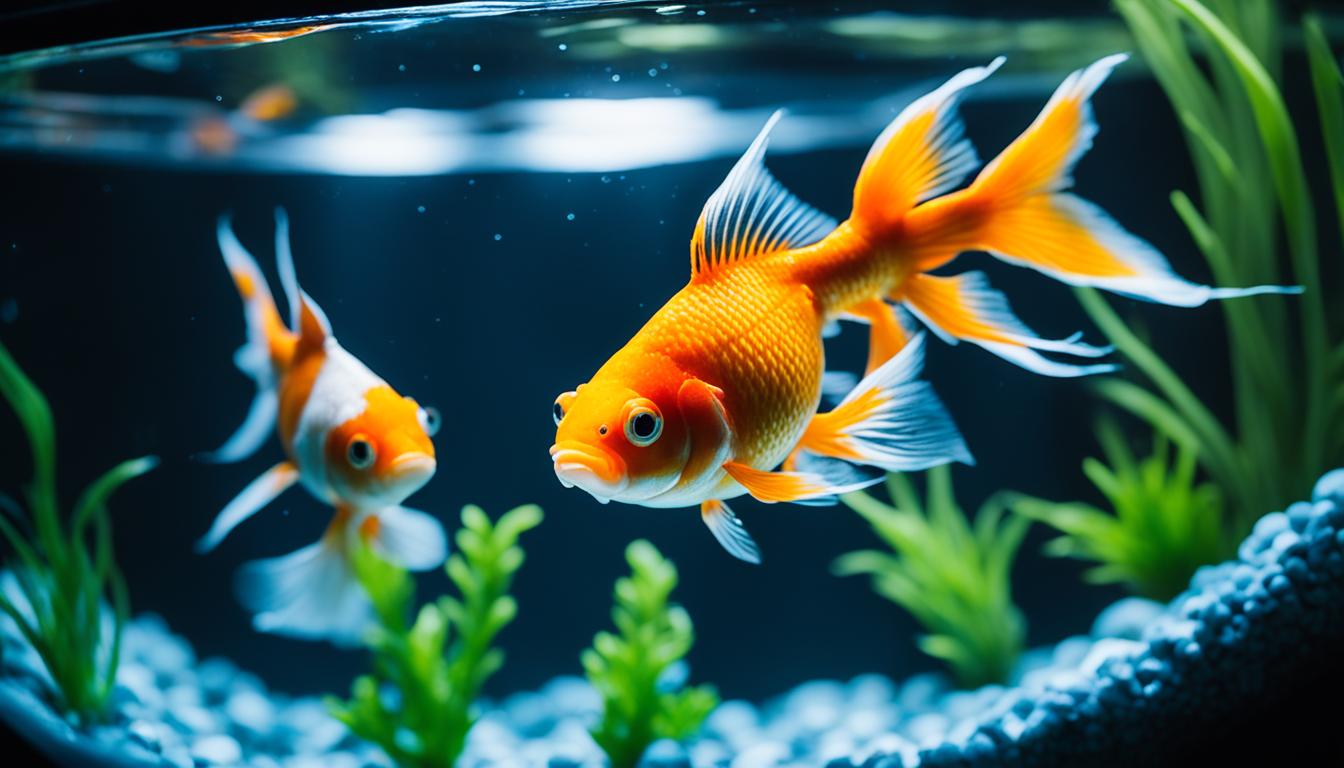Last Updated on 3 months by admin
Goldfish are a popular choice for indoor tanks, but do they need light? In this article, we will explore the importance of lighting for goldfish tanks and the requirements for keeping these beautiful fish happy and healthy.
Key Takeaways:
- Goldfish require light in their tanks to help establish a natural day and night cycle.
- Lighting promotes healthy behaviors, coloration, and growth in goldfish.
- The amount and type of lighting depend on factors like the presence of live plants.
- Maintaining proper light cycles and water quality is essential for goldfish care.
- By creating optimal aquarium conditions, goldfish can thrive and live fulfilling lives.
Why Do Goldfish Need Light?
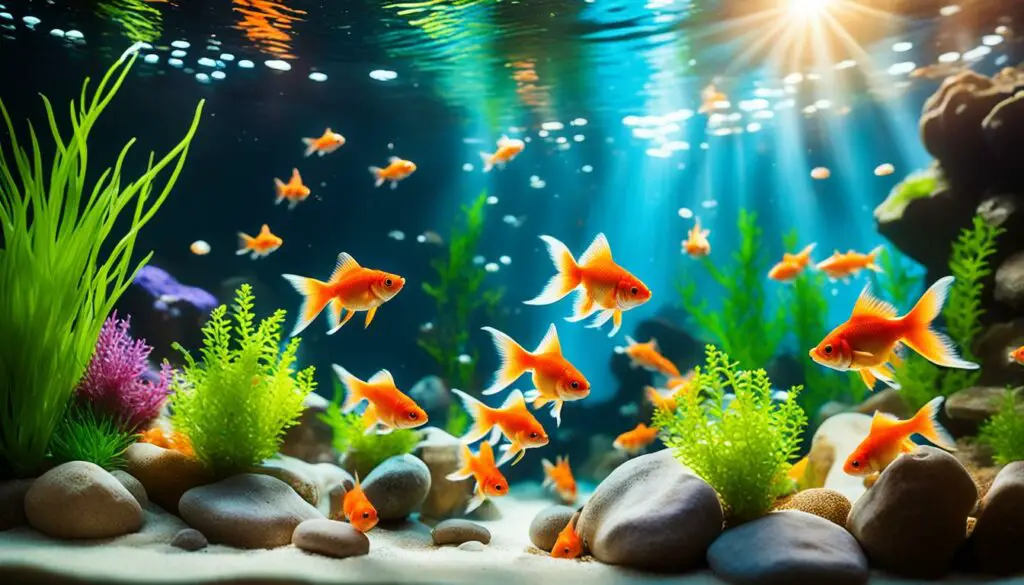
Goldfish, like all living things, have biological rhythms that are regulated by natural light cycles. In their natural habitat, they rely on the sun to provide them with the light they need to thrive. However, in an artificial tank environment, it is essential to provide goldfish with appropriate lighting to mimic these natural cycles and ensure their well-being.
Importance of Light for Goldfish
Light is not only necessary for goldfish to establish a routine for eating and sleeping but also plays a vital role in enhancing their overall health and coloration. Just like sunlight can bring out the vibrant colors of flowers, proper lighting can enhance the vibrant hues of goldfish, making them even more visually appealing in your aquarium.
“Lighting in an aquarium is crucial for the goldfish’s health and well-being. It helps them establish a natural day and night cycle, allowing them to adjust their behavior, metabolism, and immune system accordingly.”
In addition to its visual impact, light also has a significant impact on the growth of live plants in the aquarium. Plants require light for photosynthesis, a process through which they convert light energy into chemical energy, enabling them to grow and thrive. By providing the right amount of light, you can create a healthy and balanced ecosystem in your goldfish tank.
While natural light can be beneficial, it is not always practical to rely solely on sunlight. Factors such as location, weather, and accessibility can limit the amount of natural light that can reach your goldfish tank. This is where artificial lighting comes in, providing a reliable and consistent light source for your goldfish and the plants in your aquarium.
Do Goldfish Need Natural Light or Artificial Light?
Goldfish can adapt to both natural and artificial light. Natural light can provide them with the full spectrum of light required for their overall health and well-being. However, if natural light is limited or unavailable, artificial lighting can be a suitable alternative.
Artificial light for goldfish tanks is designed to imitate the natural light spectrum and intensity. There are various types of lighting options available, such as fluorescent tubes and LED lights, each with its own advantages and considerations. The choice of artificial light will depend on factors such as the type of plants, the size of the tank, and the specific requirements of the goldfish species.
To further understand the importance of light for goldfish, let’s take a closer look at how light influences their behavior and physiology.
Light plays a crucial role in regulating goldfish behavior. In their natural habitat, goldfish rely on the sun to determine their activity levels throughout the day. They are diurnal creatures, meaning they are most active during the day and rest at night. By mimicking this natural day and night cycle in your goldfish tank, you can help create a sense of familiarity and comfort for your fish.
When goldfish are exposed to consistent lighting patterns, they are more likely to establish predictable routines for feeding, resting, and exploring their environment. This routine is essential for their overall well-being and helps them maintain a healthy appetite, proper digestion, and a balanced metabolism.
How Much Light Do Goldfish Need?
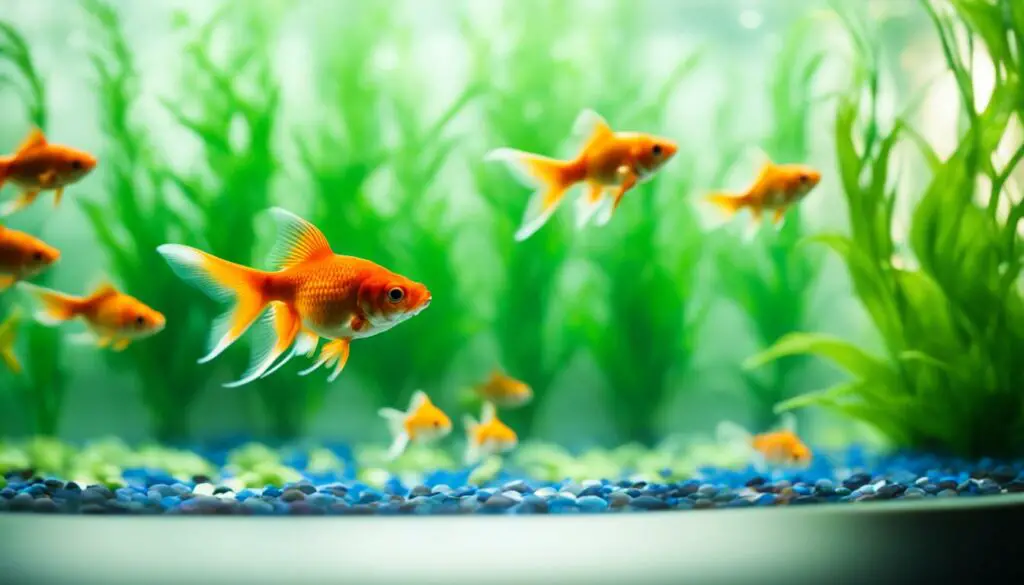
The amount of light that goldfish need in their tank depends on several factors, including the presence of artificial or live plants. Providing the proper lighting is crucial for their well-being and overall tank ecosystem.
For tanks with artificial plants, it’s important to provide enough light to differentiate between day and night. Typically, a range of 1 to 2 watts per gallon of water is sufficient. This will help establish a natural light cycle for the goldfish, allowing them to maintain their eating and sleeping patterns.
However, if your goldfish tank contains live plants, a higher amount of full-spectrum light is necessary for photosynthesis. This type of light provides a wider range of colors and wavelengths that are essential for plant growth. In such cases, it’s recommended to provide around 2 to 5 watts per gallon of water to ensure optimal plant health.
When determining the lighting requirements for your goldfish tank, it’s crucial to consider the height of the tank. Taller tanks may require stronger and more penetrative lighting to ensure that light reaches all areas of the tank effectively.
To help visualize the recommended lighting levels for goldfish tanks, consider the following table:
| Type of Tank | Lighting Requirements |
|---|---|
| Tank with Artificial Plants | Around 1 to 2 watts per gallon |
| Tank with Live Plants | Around 2 to 5 watts per gallon |
Remember, providing the proper amount of light is essential for promoting a healthy and thriving environment for your goldfish. Consider the specific needs of your tank when choosing the best lighting options available.
The Benefits of Lighting for Goldfish Tanks
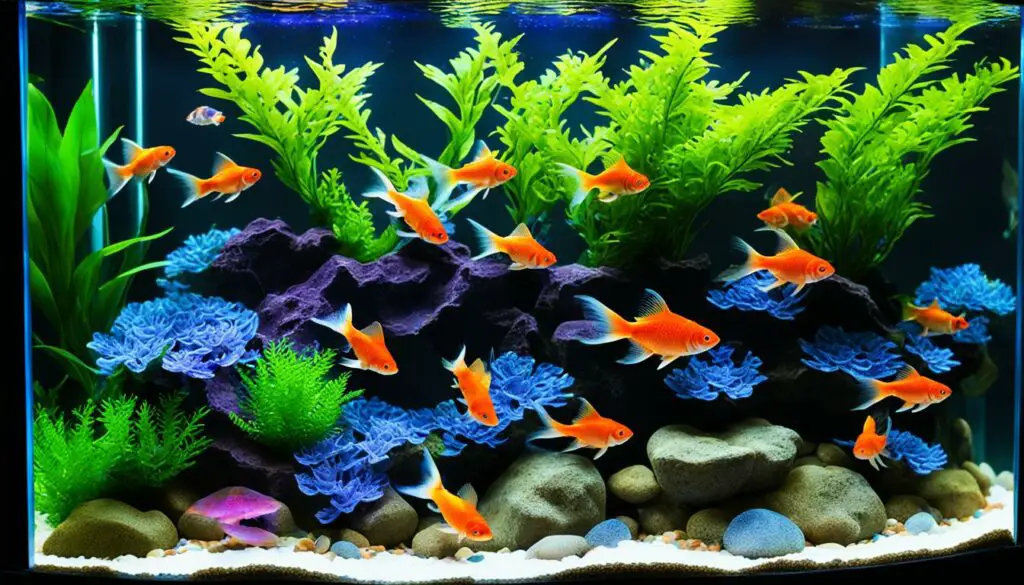
Proper lighting in goldfish tanks provides numerous benefits. It not only creates a natural day and night cycle, promoting healthy eating and sleeping patterns for the fish, but also plays a crucial role in enhancing their vibrant colors and preventing excessive algae growth in the tank. Additionally, for tanks with live plants, adequate lighting is essential for their growth and contributes to the overall aesthetic appeal of the tank.
Lighting supports the well-being of goldfish in several ways:
- Establishing a Natural Day and Night Cycle: Just like any living creature, goldfish have biological rhythms that are regulated by light cycles. By providing the right amount of light, goldfish can establish a routine for eating, sleeping, and other activities that align with their natural instincts and behavior.
- Enhancing Coloration: The vibrant colors of goldfish are truly captivating and can be further enhanced with proper lighting. Adequate light exposure helps to showcase the full range of colors and patterns that goldfish display, making them even more beautiful and fascinating to observe.
- Preventing Excessive Algae Growth: Algae growth is a common issue in aquariums, and excessive amounts can have a negative impact on water quality. Proper lighting helps to control algae growth by providing enough light for the goldfish and plants while avoiding an excess that can promote unwanted algae blooms.
- Promoting Plant Growth: Live plants not only add visual appeal to a goldfish tank but also contribute to the overall health and ecosystem balance. Lighting plays a vital role in photosynthesis, providing the necessary energy for the plants to grow and thrive. With the right lighting conditions, live plants can create a more natural and dynamic environment for goldfish.
“Proper lighting in goldfish tanks is essential for mimicking natural light cycles, enhancing goldfish coloration, preventing excessive algae growth, and promoting the growth of live plants. Creating the optimal lighting conditions not only benefits the goldfish but also enhances the overall aesthetics of the tank.”
Creating a harmonious balance of lighting in a goldfish tank is important for the well-being and enjoyment of both the fish and their owners. By providing the right amount and type of lighting, goldfish can thrive, exhibit their vibrant colors, and live in a healthy and visually appealing environment.
Can Goldfish Have Too Much Light?
While light is essential for goldfish, it is possible to provide them with excessive light, which can have negative effects on their well-being. Just like humans, goldfish have natural sleep and eating patterns that can be disrupted by too much light. Bright lights can also cause stress and discomfort for these aquatic pets.
To ensure the optimal health of your goldfish, it is important to strike a balance and mimic a natural day and night cycle. Avoid prolonged exposure to bright lights and provide periods of darkness for them to rest and rejuvenate. Direct sunlight should be avoided as it can lead to temperature fluctuations and excessive algae growth in the tank.
Excessive light can disrupt goldfish sleep and eating patterns and cause stress.
The Negative Effects of Too Much Light
Here are some drawbacks of exposing goldfish to excessive light:
- Disrupted sleep patterns: Goldfish need periods of darkness to rest and maintain a healthy sleep cycle. Too much light can disrupt their sleep patterns, leading to increased stress and fatigue.
- Disrupted eating patterns: Goldfish have natural feeding behaviors and prefer to eat during specific times of the day. Excessive light can interfere with their eating patterns, causing loss of appetite or overeating.
- Increased stress: Bright lights can be overwhelming for goldfish and induce stress. This can weaken their immune system and make them more susceptible to diseases.
By providing the right balance of light and darkness, you can help create a calming and comfortable environment for your goldfish, promoting their overall well-being.
| Negative Effects of Excessive Light for Goldfish | Descriptions |
|---|---|
| Disrupted sleep patterns | Goldfish need periods of darkness to rest and maintain a healthy sleep cycle. Too much light can disrupt their sleep patterns, leading to increased stress and fatigue. |
| Disrupted eating patterns | Goldfish have natural feeding behaviors and prefer to eat during specific times of the day. Excessive light can interfere with their eating patterns, causing loss of appetite or overeating. |
| Increased stress | Bright lights can be overwhelming for goldfish and induce stress. This can weaken their immune system and make them more susceptible to diseases. |
How Many Hours of Light and Dark Do Goldfish Need?
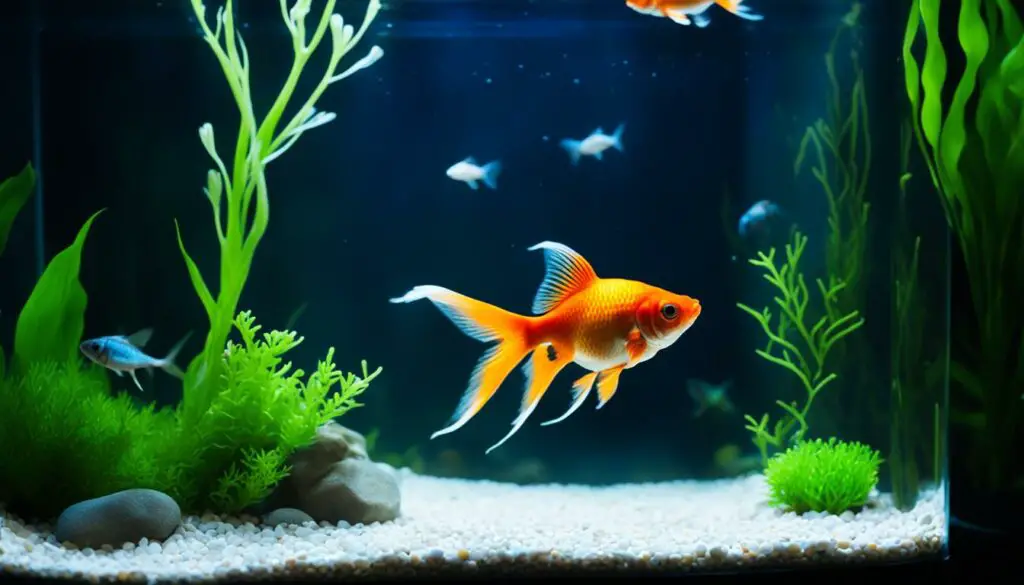
To ensure the well-being of your goldfish, it is important to establish a proper light cycle that mimics their natural environment. This includes providing them with the optimal duration of light and darkness in their tank.
Goldfish require a regular cycle of both light and darkness to regulate their sleep patterns and biological functions. While they need light for certain periods, they also need darkness for rest and rejuvenation. It is during the dark hours that goldfish can rest, recover, and recharge.
To meet the needs of your goldfish, they should receive between 8 to 12 hours of darkness each night. This allows them to establish a consistent routine and promotes a healthy sleep cycle. By providing them with the appropriate amount of darkness, you are helping to support their overall well-being.
One useful tool for maintaining a consistent light cycle is a mains timer. This device allows you to program specific hours of light and darkness for your goldfish tank. With a timer, you can ensure that your goldfish receives the proper amount of darkness each night, even if you’re not available to manually adjust the lighting.
Benefits of a Consistent Light Cycle
“Establishing a consistent light cycle for your goldfish tank is crucial for their overall health and well-being. It helps regulate their sleep patterns, supports their biological functions, and promotes a natural environment that mimics their natural habitat.”
Having a consistent light cycle not only benefits the goldfish but also allows you to observe their behavior more effectively. It helps you identify any changes or abnormalities in their activity levels, appetite, or overall health.
Remember to choose a suitable lighting source that provides the right spectrum and intensity for your goldfish tank. This will ensure that your goldfish receive the optimal light duration while also considering their specific needs, such as the presence of live plants in the tank.
By providing your goldfish with the appropriate amount of light and darkness, you are creating an environment that promotes their natural behaviors and supports their overall health and well-being.
Next, we’ll explore the different types of aquarium lighting options available for goldfish tanks.
Types of Aquarium Lighting
When it comes to lighting options for goldfish tanks, there are several choices available. Each type of lighting has its own advantages and considerations to keep in mind. Let’s explore three common types of goldfish tank lighting:
1. Incandescent Bulbs
Incandescent bulbs were once the go-to option for aquarium lighting, but they are rarely used today. These bulbs generate a significant amount of heat, which can be detrimental to the temperature and stability of the tank. Additionally, incandescent bulbs are not energy-efficient, making them less cost-effective in the long run.
2. Fluorescent Tubes
Fluorescent tubes are a popular choice for goldfish tank lighting. They come in various lengths and color ranges, allowing you to customize the lighting to your preference. Fluorescent tubes are more energy-efficient compared to incandescent bulbs and provide a good balance of light intensity for goldfish and the growth of live plants in the tank.
3. LED Lighting
LED lighting is gaining popularity among goldfish tank enthusiasts. These lights offer excellent energy efficiency and have a long lifespan, making them a cost-effective option in the long term. LED lights also produce less heat, reducing the risk of temperature fluctuations in the tank. It is important to choose LED lights that offer a full-spectrum light, mimicking natural daylight. This is beneficial for goldfish coloration and the growth of live plants.
Choosing the right type of lighting for your goldfish tank depends on various factors, including your goals, preferences, and the presence of live plants. Consider the specific needs of your goldfish and the aesthetic you want to achieve in your tank. The table below summarizes the key features of each lighting option:
| Lighting Type | Advantages | Considerations |
|---|---|---|
| Incandescent Bulbs | – Easy availability – Suitable for simple setups |
– Generate heat – Less energy-efficient |
| Fluorescent Tubes | – Come in different lengths and color ranges – Energy-efficient – Good balance between light intensity and plant growth |
– Not as long-lasting as LED lights |
| LED Lighting | – Energy-efficient – Longer lifespan – Produces less heat |
– Initial cost may be higher |
By understanding the pros and cons of each lighting option, you can make an informed decision that suits your goldfish tank and meets the needs of your aquatic pets.
Tips for Using Aquarium Lighting
Proper lighting is essential for maintaining a healthy and vibrant goldfish tank. Here are some tips to help you make the most of your aquarium lighting:
- Use an Aquarium Lighting Timer: Investing in an aquarium lighting timer is highly recommended. These timers ensure a consistent light cycle for your goldfish while providing the necessary darkness they need. By automating the lighting schedule, you can eliminate the risk of human error and provide a stable environment for your fish to thrive.
- Monitor Light Intensity: It’s important to monitor the intensity of your aquarium lighting. Insufficient light may result in poor coloration and stunted plant growth, while excessive light can lead to algae overgrowth and stress your goldfish. Find the right balance by using a light meter to measure the intensity and adjust accordingly.
- Adjust Lighting Duration and Intensity: Each goldfish tank is unique, and the lighting requirements may vary. It’s essential to observe your goldfish and plants to determine the optimal lighting duration and intensity. Increasing or decreasing the lighting duration or intensity may be necessary to meet their specific needs and maintain a healthy environment.
By following these goldfish tank lighting tips, using an aquarium lighting timer, and maintaining proper light intensity, you can provide the ideal lighting conditions for your goldfish and create a beautiful and thriving aquatic habitat.
Goldfish Tank Maintenance and Cleaning
Regular maintenance is essential for the care of your goldfish tank. By performing routine cleaning tasks and keeping the water quality in check, you can ensure a healthy and thriving environment for your beloved fish.
To maintain optimal water quality, it is crucial to regularly perform water changes in your goldfish tank. This helps control nutrient levels and remove physical waste, keeping the water clean and balanced. Aim to change approximately 20% of the water every 1-2 weeks, depending on the size of your tank.
Cleaning the gravel and filter in your goldfish tank is another important aspect of maintenance. Using a siphon vacuum, gently remove any debris or waste that has settled on the bottom of the tank. Additionally, rinse the filter media regularly in aquarium water to prevent clogging and maintain proper filtration.
Proper lighting also plays a crucial role in the maintenance of goldfish tanks. Adequate lighting helps control algae growth by balancing the photosynthetic activity in the tank. Ensure your tank is exposed to an appropriate amount of light each day, balancing the needs of your goldfish and any live plants you may have.
Tips for Goldfish Tank Maintenance:
- Perform regular water changes to maintain water quality and control nutrient levels.
- Clean the gravel and filter regularly to remove debris and prevent clogging.
- Rinse equipment in aquarium water to avoid introducing chemicals or contaminants.
- Maintain proper lighting to control algae growth and create a healthy environment.
“Regularly cleaning your goldfish tank and maintaining water quality is essential for the health and well-being of your fish. By following these maintenance tips, you can create a clean and thriving habitat for your aquatic companions.”
| Goldfish Tank Maintenance Checklist | Frequency |
|---|---|
| Performing water changes | Every 1-2 weeks |
| Cleaning gravel | Once a month |
| Rinsing filter media | Once a month |
| Checking and adjusting lighting | Regularly |
Goldfish Tank Diseases and Light Considerations
Proper lighting and water conditions play a crucial role in preventing goldfish diseases and maintaining a healthy tank ecosystem. Light has a direct impact on algae growth, and imbalances in lighting can lead to water quality issues. By monitoring light levels and taking appropriate measures, you can ensure the well-being of your goldfish.
“Lighting and water conditions are essential factors in preventing goldfish diseases and maintaining a thriving aquarium.”
Preventing Algae Growth
Excessive or insufficient lighting can contribute to algae overgrowth in goldfish tanks. While some algae growth is normal, excessive amounts can be harmful to the fish and disrupt the tank ecosystem. By maintaining appropriate lighting levels, you can prevent the proliferation of algae and keep your tank clean and healthy.
When setting up a new tank, it is common to encounter brown algae, also known as diatoms. Diatoms thrive in newly established tanks due to high nutrient levels. Controlling nutrient levels and ensuring proper lighting can help manage diatom growth. Regular water testing and appropriate water changes are essential in preventing algae blooms and maintaining water quality.
Light and Nitrate Levels
In addition to algae growth, lighting can also have an impact on nitrate levels in the tank. Nitrate is a byproduct of the nitrogen cycle and can accumulate over time. High nitrate levels can be harmful to goldfish and lead to health problems. Adequate lighting plays a role in the growth of beneficial bacteria that help convert nitrate into less harmful forms.
By maintaining proper lighting and conducting regular water changes, you can keep nitrate levels in check and maintain a healthy environment for your goldfish. It is important to monitor nitrate levels using a water testing kit and take appropriate action if levels become elevated.
Common Goldfish Diseases and Preventive Measures
| Disease | Symptoms | Preventive Measures |
|---|---|---|
| Ich (White Spot Disease) | White spots on the fish’s body, lethargy, loss of appetite | Quarantine new fish, maintain proper water temperature and quality, avoid stress |
| Fin Rot | Torn, frayed, or decaying fins | Maintain clean water conditions, avoid overcrowding, provide proper nutrition |
| Swim Bladder Disorder | Difficulty swimming or floating upside down | Avoid overfeeding, provide a balanced diet, maintain good water quality |
By being proactive in maintaining proper lighting and water conditions, you can prevent many common goldfish diseases. Regular monitoring of water parameters, appropriate lighting levels, and proper tank maintenance are key to ensuring the health and well-being of your goldfish.
The Role of Light in Goldfish Well-being
Adequate lighting is crucial for the overall well-being of goldfish. The right amount and quality of light can have a significant impact on their health, behavior, and longevity. Let’s explore how light benefits goldfish in various aspects of their lives.
Promoting Natural Behaviors
Light plays a vital role in promoting natural behaviors among goldfish. These fascinating aquatic creatures are diurnal, meaning they are active during the day and rest during the night. By providing a proper light cycle, goldfish can establish a routine for eating, exploring their surroundings, and interacting with other fish in the tank.
Goldfish are known to be curious and social creatures. Adequate lighting ensures they have a stimulating environment to thrive in, allowing them to display their natural behaviors to the fullest.
Enhancing Coloration
One of the most captivating aspects of goldfish is their vibrant and varied colors. Light plays a crucial role in enhancing and maintaining their beautiful coloration. Natural and artificial light sources help bring out the pigments in their scales, making them appear more vibrant and eye-catching.
Proper lighting conditions also contribute to the overall visual appeal of the goldfish tank, creating a visually stunning and attractive display.
Supporting Plant Growth
If you have live plants in your goldfish tank, proper lighting becomes even more important. Light is the primary energy source for photosynthesis, the process by which plants convert light into energy. By providing sufficient light, you create an ideal environment for plants to grow and thrive.
The plants not only add oxygen to the tank but also serve as natural filtration systems, helping to maintain water quality for the goldfish. They also provide additional hiding places, creating a more natural and stimulating environment for the fish.
| Benefits of Light for Goldfish | Summary |
|---|---|
| Promotes natural behaviors | Establishes routine for eating and sleeping |
| Enhances coloration | Makes goldfish appear more vibrant and attractive |
| Supports plant growth | Creates a natural and stimulating environment |
This table summarizes the key benefits of light for goldfish health, behavior, and longevity.
With the right care and attention to lighting, goldfish can live long and fulfilling lives in captivity. Lighting, along with proper nutrition, tank maintenance, and water quality, plays a vital role in ensuring the well-being of these beloved aquatic pets.
Conclusion
In conclusion, providing appropriate lighting is essential for the well-being of goldfish in their tanks. The amount and type of lighting required depend on various factors, including the presence of live plants in the tank. By following a few key principles, such as establishing a proper light cycle, maintaining water quality, and monitoring the tank ecosystem, goldfish owners can create optimal conditions for their pets to thrive.
Light plays a vital role in goldfish care as it helps regulate their biological rhythms, enhances their coloration, and supports the growth of live plants in the tank. It is important to strike a balance by providing adequate light while avoiding excessive brightness. Monitoring the intensity and duration of lighting, using timers for consistent light cycles, and selecting the right type of lighting are all crucial aspects of goldfish tank maintenance.
With the right care and attention to lighting and other essentials, goldfish can live long and happy lives in captivity, bringing joy to their owners for many years to come. By understanding the importance of lighting and implementing the optimal lighting practices, goldfish owners can create a vibrant and healthy environment for their aquatic companions.
FAQ
Do goldfish need light in their tanks?
Yes, goldfish do need light in their tanks. Light helps establish a natural day and night cycle, promotes healthy eating and sleeping patterns, enhances their coloration, and supports the growth of live plants in the tank.
Why is light important for goldfish?
Light is important for goldfish because it helps mimic the natural light cycles that regulate their biological rhythms. It supports their routine for eating and sleeping, enhances their vibrant colors, and promotes the growth of live plants in the tank.
How much light do goldfish need?
The amount of light needed in a goldfish tank depends on several factors. For tanks with artificial plants, provide enough light to differentiate between day and night, typically around 1 to 2 watts per gallon of water. For tanks with live plants, a higher intensity of full-spectrum light (2-5 watts per gallon) is necessary for photosynthesis. The height of the tank may also influence the lighting requirements.
What are the benefits of lighting for goldfish tanks?
Lighting in goldfish tanks offers multiple benefits. It helps establish a natural day and night cycle, promotes healthy eating and sleeping patterns, enhances goldfish coloration, and prevents excessive algae growth in the tank. For tanks with live plants, proper lighting is crucial for their growth and overall tank aesthetics.
Can goldfish have too much light?
Yes, goldfish can have too much light. Excessive light can disrupt their natural sleep and eating patterns, causing stress. It is important to strike a balance by mimicking a natural day and night cycle and avoiding bright lights. Direct sunlight should also be avoided to prevent temperature fluctuations and algae blooms in the tank.
How many hours of light and dark do goldfish need?
Goldfish should receive between 8 to 12 hours of darkness each night to mimic natural conditions and regulate their sleep and biological functions. Using an aquarium lighting timer can help establish a consistent light cycle and ensure the fish receive the proper amount of darkness.
What are the types of aquarium lighting available for goldfish tanks?
There are various types of lighting options available for goldfish tanks. These include incandescent bulbs (rarely used now due to heat generation), fluorescent tubes (varying lengths and color ranges), and LED lighting (energy-efficient and long lifespan). Choose a full-spectrum light that mimics natural daylight for optimal plant growth and fish coloration.
What are some tips for using aquarium lighting?
It is recommended to use an aquarium lighting timer to maintain a consistent light cycle and ensure the fish receive the right amount of darkness. Monitor the intensity of the light to prevent algae overgrowth and provide enough light for live plants. Adjust the lighting duration and intensity as needed based on the specific needs of the goldfish and the tank environment.
How should I clean and maintain my goldfish tank?
Regular maintenance is essential for goldfish tank care. Perform regular water changes to control nutrient levels and remove physical waste. Clean the gravel and filter, and rinse equipment in aquarium water to maintain a healthy environment. Adequate lighting plays a role in controlling algae growth and maintaining water quality.
Can light affect goldfish diseases?
Light can influence the growth of algae, and excessive or insufficient lighting can lead to imbalances in the tank ecosystem. Brown algae (diatoms) often appear in newly set-up tanks and can be managed by minimizing nutrient levels and maintaining appropriate lighting. Regular water testing and appropriate water changes are also important in preventing water quality issues.
What is the role of light in goldfish well-being?
Adequate lighting is crucial for the overall well-being of goldfish. It promotes their natural behaviors, enhances their coloration, and supports the growth of live plants in the tank. Proper light cycles help establish a routine for eating and sleeping, leading to healthy and happy fish.
Source Links
- https://www.mypetwarehouse.com.au/my-pet-blog/pet-care/fish/how-to-care-for-goldfish
- https://www.hepper.com/do-goldfish-need-light/
- https://www.fishkeeping.co.uk/modules/newbb/reply.php?topic_id=6894

